#developmental psychology
Text

Susan Nathiel, Daughters of Madness
387 notes
·
View notes
Text
i’m in a developmental psych class right now and talk of gendered play is making me wonder if some of my experiences were just me or if they were more common than my textbook is teaching.
so, how often did you “play rough” (wrestling, play-fighting, etc) with others as a kid?
506 notes
·
View notes
Text

I never normally work in cafés, but I realised recently that I am actually... absolutely allowed to do that? 😅 And it's so nice?
So I'm giving it another try today. I have a really delicious blueberry banana bread (already half-eaten, oops!). And I'm posting here for accountability. Because the goal is to write 1000 words within the next two hours!! 💻🍰☕️
33 notes
·
View notes
Text
Watching the original version of Disney’s Pinocchio after studying developmental psychology is a bad idea, because the whole film is just…so terrible in terms of how everything is presented to Pinocchio. Like, he’s brought to life late at night, and in the span of 24 hours, he gets kidnapped twice and gets constantly manipulated by literally everyone around him, and then he’s punished for being manipulated.
“Oh, but he should’ve listened to Jiminy and done what he was told!” - Listen here, you son of a bitch, that poor puppet was brought to life and then expected to just go to school without any socialization or time spent with his father. That boy had no business going to school in the first place since he knew literally nothing and should’ve been acclimated to listening to Jiminy in the safety of his own home. Not only that, but Pinocchio continued to be punished for making choices despite the fact that literally nobody warned him about the dangers of trusting people he doesn’t know. He was never taught stranger danger, yet he kept getting punished for trusting people he had never been told not to trust. Also, nobody gave him a good reason to go to school? He was just expected to go because he was told to?
Bottom line is that Pinocchio kept getting let down by the authority figures in his life and was punished for it, and I’ve had enough of that-
#pinocchio#disney’s pinocchio#child psychology#developmental psychology#this movie makes me angry#the puppet was continually let down#and this poor boy had to fucking die to become human#he had to experience death in order to be considered worthy#yeah give the kid trauma#that won’t end terribly for anyone
24 notes
·
View notes
Text


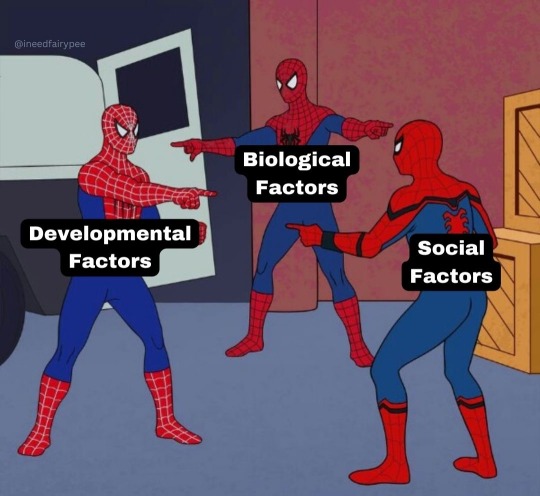

Psychology be like…
#psychology#psychology memes#psychology student#psychology facts#spiderman meme#psychology studyblr#mental illness#mental health#mental health memes#psychology nerd#student memes#university memes#psych student#child psychology#developmental psychology#original content#oc meme#oc#meme maker#psych#oc memes#ineedfairypee#fairypeememes#I Need Fairy Pee
59 notes
·
View notes
Text
Science Says People (Specifically Kids) Are Good, Actually
okay i just rediscovered the link to one of my favourite studies ever and i wanted to share it with the class.
Koomen, R., Grueneisen, S., & Herrmann, E. (2020). Children Delay Gratification for Cooperative Ends. Psychological Science, 31(2), 139–148. https://doi.org/10.1177/0956797619894205
(it's behind a paywall, but if you can't access and you're interested i have the pdf)
This study modified the marshmallow test, where kids are asked to hold off on eating one marshmallow in order to get another one later. The study used children from Germany and Kenya, with localised treats that were familiar to the kids. 70 of the children were paired up interdependently - each pair would only get the second treat if they both held off eating the first. 69 (nice) were paired up dependently - they each thought that they were the only one of the two who had to avoid eating the treat, and 68 were doing the test as normal.
The interdependent kids were significantly better at the test than those doing the test normally - cooperation (the idea that they were doing this for AND with a friend) had a significant positive effect on their willpower ! The dependent kids were also better at the test than the solo ones - showing that children can delay gratification better when they're doing it for a friend - but not as much as the interdependent ones. Even though they knew that they were the only ones who had to hold out, the fact that they weren't doing it with a friend meant they didn't have that amazing boost of willpower. (there are small cultural differences here between the Kenyan and German children, but the overall interdependence effect holds.)
From the discussion: "Delaying gratification is often critical for cooperation to succeed. Here, 5- to 6-year-olds from two highly distinct cultures were more likely to delay gratification when their outcomes were interdependently linked than when they performed the same task alone, even though the interdependent context entailed additional risks. These findings support the notion that human cooperative relations, particularly social interdependence, critically shape cognitive performance from an early age."
i just find this study so heartening, because it's truly applicable throughout life. if you've ever done something for a friend that you couldn't do for yourself, that's this effect! our reliance on others (and their reliance on us) is hugely beneficial for ourselves and for society - how nice is that?
Similar studies:
this one again shows increased willpower in kids for the good of others !
this one shows how kids begin to give more to people that need it
this one found that kids as young as three show altruistic behaviour when it comes to the present, and by five they've developed altruism for future events !
this study found that by the age of 8, children will reject unfairness EVEN WHEN IT BENEFITS THEM !!
in summary i love people and i love children and we are all built kind it is our duty to make sure as many people as possible stay that way
#i'll send anyone a pdf of any of these feel free to ask for them#child development#psychology#child psychology#developmental psychology#altruism#marshmallow test#positivity#optimism#love#people are good#faith in humanity#science#please add any other studies you know of in the replies/reblogs ! i love this field with all my heart#cool stuff#sky (the blogger) originals
55 notes
·
View notes
Text
youtube
I wanted to share this short animated video on how our brains develop in childhood. It touches on some important topics like how the caregiver-child's relationship is vital in early development, and how stress can impact the brain.
#trauma#complex trauma#dissociation#brain development#psychology#adverse childhood experiences#childhood trauma#developmental psychology#academic
28 notes
·
View notes
Text
Crying reading my psych text bc why tf do I show all signs of insecure attachment in childhood. I wasn’t a “shy kid” I was just insecure in all my relationships bc I had a mother that didn’t care about me
4 notes
·
View notes
Text
Okay so I respect Erik Erikson for all he's done for psychology with his stages of development but my GOD his parents were not creative AT ALL when naming him. Erik Erikson, really?? Good luck being successful in the identity vs. role confusion stage with a dumb name like that smh
2 notes
·
View notes
Text
Life-Span Development John Santrock Chapter 3 Notes
-gernminal period- is the period of prenatal development that takes place during the first two weeks after conception. It includes the creation of the fertilized egg, or a zygote; cell division; and the attachment of the zygote to the uterine wall
-differentiation- specialization of cells to perform various tasks
-blastocyst- consists of an inner mass of cells that will eventually develop into the embryo
-trophoblast- an outer layer of cells that later provides nutrition and support for the embryo
-implantation- the attachment of the zygote to the uterine wall
-embyronic period- the period of prenatal development that occurs from two to eight weeks after conception. During this period, the rate of cell differentiation intensifies, support systems for cells form, and organs appear.
-embryo- the blastocyst attaches to the uterine wall and the mass of cells is now called an embryo
-endoderm- the inner layer of cells, which will develop into the digestive and respiratory systems
-mesoderm- the middle layer, which will become the circulatory system, bones, muscles, excretory system, and reproductive system
-ectoderm- the outermost layer, which will become the nervous system and brain, sensory receptors (ear, nose, and eyes, for example), and skin parts (hair and nails, for example)
-the endoderm primarily produces internal body parts, the mesoderm primarily produces parts that surround the internal areas, and the ectoderm primarily produces surface parts
-amnion- a sac (bag or envelope) that contains a clear fluid in which the developing embryo floats
-umbilical cord- contains two arteries and one vein, and connects the baby to the placenta
-placenta- consists of a disk-shaped group of tissues in which small blood vessels from the mother and the offspring intertwine but do not join
-organogenesis- the name give to the process of organ formation during the first two months of prenatal development
-fetal period- lasting about seven months, is the prenatal period between two months after conception and birth in typical pregnancies. Growth and development continue their dramatic course during this time.
-neurons- or nerve cells, which handle information processing at the cellular level in the brain
-Four important phases of the brain's development during the prenatal period involve: (1) the neural tube, (2) neurogenesis, (3) neuronal migration, and (4) neural connectivity.
-As the human embryo develops inside it's mother's womb, the nervous system begins forming as a long, hollow tube located on the embryo's back. This pear-shaped neural tube, which forms at about 18 to 24 days after conception, develops out of the ectoderm. The tube closes at the top and bottom ends at about 27 days after conception.
-A massive proliferation of new immature neurons begins to take place at about the fifth prenatal week and continues throughout the remainder of the prenatal period. The generation of new neurons is called neurogenesis, a process that continues through the remainder of the prenatal period but is largely complete by the end of the fifth month after conception. At the peak of neurogenesis, it is estimated that as many as 200,000 neurons are generated every minute.
-neuronal migration- involves cells moving outward from their point of origin to their appropriate locations and creating the different levels, structures, and regions of the brain
-teratogen- is any agent that can potentially cause a birth defect or negatively alter cognitive and behavioral outcomes.
-The field of study that investigates the causes of birth defects is called teratology.
-The does, genetic susceptibility, and the time of exposure to a particular teratogen influence both the severity of the damage to an embryo or fetus and the type of defect:
-Dose- The dose effect is rather obvious--the greater the dose of an agent, such as drug, the greater the effect.
-Genetic susceptibility- The type or severity of abnormalities caused by a teratogen is linked to the genotype of the pregnant woman and the genotype of the embryo or fetus. For example, how a mother metabolizes a particular drug can influence the degree to which the drug's effects are transmitted to the embryo or fetus. Also, for unknown reasons, male fetuses are far more likely to be affected by teratogens than female fetuses.
-Time of exposure- Exposure to teratogens does more damage when it occurs at some points of development than at others. Damage during the germinal period may even prevent implantation. In general, the embryonic period is more vulnerable than the fetal period.
-embryonic period- when organs are being formed
-a critical period is a fixed time period very early in development during which certain experiences or events can have a long-lasting effect on development.
-psychoactive drugs- act on the nervous system to alter states of consciousness, modify perceptions, and change moods
-fetal alcohol spectrum disorders (FASD)- are a cluster of abnormalities and problems that appear in the offspring of mothers who drink alcohol heavily during pregnancy
-afterbirth- is the third stage, at which time the placenta, umbilical cord, and other membranes are detached and expelled. This final stage is the shortest of the three birth stages, lasting only minutes.
-midwifery- is a profession that provides health care to women during pregnancy, birth, and the postpartum period
-doula- is a Greek word that means "a woman who helps." A doula is a caregiver who provides continuous physical, emotional, and educational support for the mother before, during, and after childbirth
-analgesia- is used to relieve pain. Analgesics include tranquilizers, barbiturates, and narcotics.
-anesthesia- is used in late first-stage labor and during delivery to block sensation in an area of the body or to block consciousness
-oxytocin- is a hormone that promotes uterine contractions; a synthetic form called Pitocin is widely used to decrease the duration of the first stage of labor
-natural childbirth- is the method that aims to reduce the mother's pain by decreasing her fear by providing information about childbirth and teaching her and her partner to use breathing methods and relaxation techniques during delivery.
-Bradley Method- a type of natural childbirth that is used today which involves husbands as coaches, relaxation for easier birth, and prenatal nutrition and exercise
-prepared childbirth- or the Lamaze method. It includes a special breathing technique to control pushing in the final stages of labor, as well as more detailed education about anatomy and physiology
-cesarean delivery- the baby is removed from the mother's uterus through an incision made in her abdomen. Cesarean deliveries are performed if the baby is lying crosswise in the uterus, if the baby's head is too large to pass through the mother's pelvis, if the baby develops complications, or if the mother is bleeding vaginally.
-breech position- the baby's buttocks are the first part to emerge from the vagina
-Apgar Scale- is widely used to assess the health of newborns at one and five minutes after birth. The Apgar Scale evaluates an infant's heart rate, respiratory effort, muscle tone, body color, and reflex irritability.
-Brazelton Neonatal Behaviroal Assessment (NBAS)- named after American pediatrician T. Berry Brazelton (1918-2018). The NBAS typically is performed 24 to 36 hours after birth. It is also used as a sensistive index of neurological competence up to one month after birth for typical infants and as a measure in many studies of infant development. The NBAS assesses the newborn's neurological development, reflexes, and reactions to people and objects.
-Neonatal Intensive Care Unit Network Neuro behavorial scale (NNNS)- provides another assessment of the newborn's behavior, neurological and stress responses, and regulatory capacities
-low birth weight infants- weigh less than 5 pounds 8 ounces at birth. Very low birth weight newborns weigh less than 3 pounds 4 ounces, and extremely low birth weight newborns weigh less than 2 pounds 3 ounces.
-preterm infants- are those born three weeks or more before the pregnancy has reached its full term- in other words, 35 or fewer weeks after conception
-small for date infants- are those whose birth weight is below normal when the length of pregnancy is considered. They weigh less than 90 percent of all babies of the same gestational age. Small for date infants may be preterm or full term.
-extremely preterm infants- are those born at less than 28 weeks gestation
-very preterm infants- are those born at less than 33 weeks of gestational age
-kangaroo care- involves skin-to-skin contact in which the baby, wearing only a diaper, is held upright against the parent's bare chest. Kangaroo care is typically practiced for two to three hours per day, skin-to-skin over an extended time in early infancy.
-postpartum period- the period after childbirth or delivery that lasts for about 6 weeks or until the mother's body has completed its adjustment and has returned to a nearly prepregnant state. It is a time when the woman adjusts, both physically and psychologically, to the process of childbearing
-postpartum depression- involves a major depressive episode that typically occurs about four weeks after delivery. Women with postpartum depression have such strong feelings of sadness, anxiety, or despair that for at least a two-week period they have trouble coping with their daily tasks
-bonding- the formation of a connection, especially a physical bond between parents and the newborn in the period shortly after birth
All From The Life-Span Development by John W. Santrock Chapter 3
#developmental psychology#life span development#psychology#college#college life#student#textbook notes
4 notes
·
View notes
Text
In nursing school, we were told that infants need to be fed every 2 hours if on breast milk or 3 if on formula and the whole time I'm thinking like, how the FUCK were infants fed 1000 years ago??? It's not like back then they had medical professionals telling them this info. But it turns out they probably just strapped the infant to the chest 99% of time and that just makes so much more sense
8 notes
·
View notes
Text
It’s hard to discount what every nerve in your body is telling you, even if it’s incorrect. Again, there’s that dilemma—you may know there’s not an emergency, but your feelings say that there is. It seems that, as developing infants, we need a pretty high proportion of good stuff to bad. Negative states are inevitable and normal, but if they outweigh the positive states, there’s going to be trouble ahead. Putting together ‘‘bonds’’ and ‘‘brains,’’ it seems that we need a secure attachment, with plenty of positive feelings, comfort, and stability, in order for our brains and minds to develop as they should. So this is not just about having a nice childhood with pleasant memories or the opposite, it’s literally about how well the brain develops and what working models, or templates, the infant brain is constructing in the midst of all these experiences.
Susan Nathiel, Daughters of Madness
70 notes
·
View notes
Text
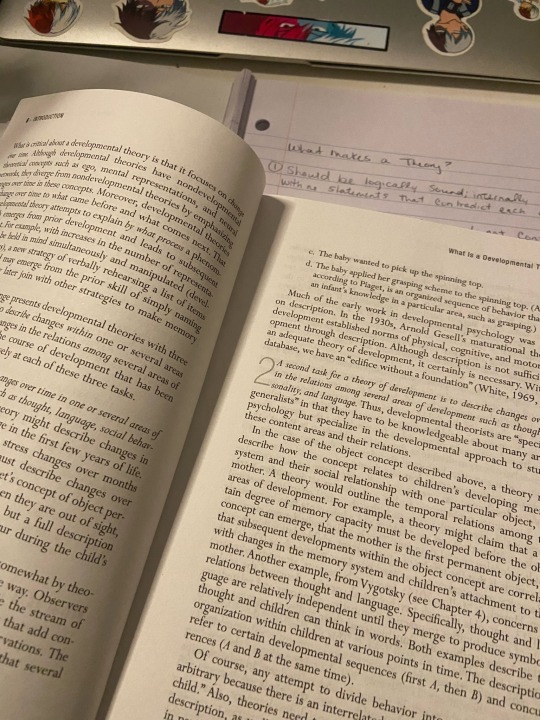
Class starts next week and I am getting ready to Ace it!
#doctoral student#educational psychology#blackphdstudent#studyblr#academic research#black college girl#student#educational research#qualitative research#research design#developmental psychology
14 notes
·
View notes
Text
i feel like the crisis age thing gets kinda overlooked after the child is seven. like i still have soul altering experiences every two years why did we decide its just 1 3 and 5 years old?
#should i actually tag this in a way that would put this on a psychologists feed or would i just embarrass myself#is there such a thing as psychologists tumblr?#i feel like everyone would hate even the idea of this#idk how to tag this#character development#developmental psychology#am i just mentally a seven year old#cause id accept that
5 notes
·
View notes
Video
youtube
Jonathan Haidt: The moral roots of liberals and conservatives
The worst idea in all of psychology is the idea that the mind is a blank slate at birth. Developmental psychology has shown that kids come into the world already knowing so much about the physical and social worlds. and programmed to make it really easy for them to learn certain things, and hard to learn others.
The “first draft” of the moral mind:
“The initial organization of the brain does not rely that much on experience… Nature provides a first draft, which experience then revises… ‘Built–in” does not mean unmalleable; it means organized in advance of experience.”
(Marcus, 2004)
So what's on the first draft of the moral mind? To find out, my colleague Craig Joseph and I read through the literature on anthropology, on cultural variation and morality, and also on evolutionary psychology, looking for matches.
What are the sorts of things that people talk about across disciplines, that you find across cultures, and even across species?
We found five. Five best matches, which we call the five foundations of morality:
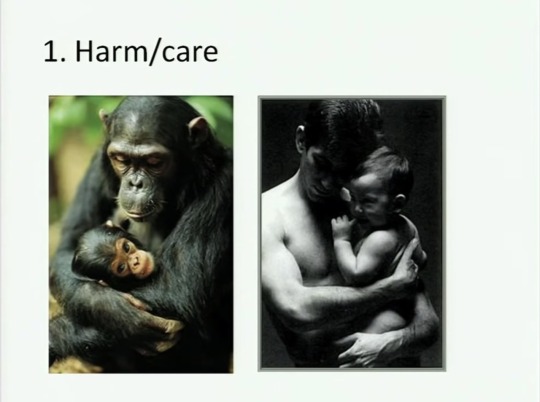



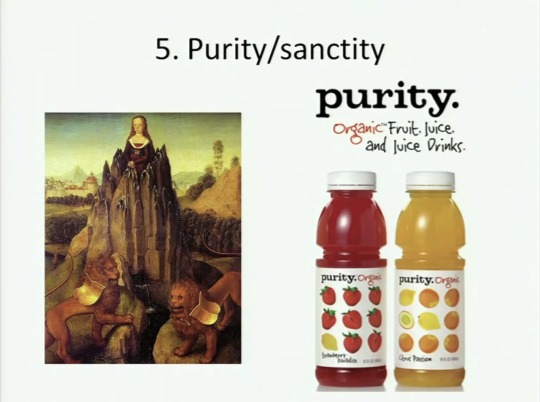
#Jonathan Haidt#moral psychology#evolution of morality#morality#religious morality#developmental psychology#evolutionary psychology#psychology#psychology of morality#conservative#progressive#blank slate#blank slateism#religion is a mental illness
30 notes
·
View notes
Text
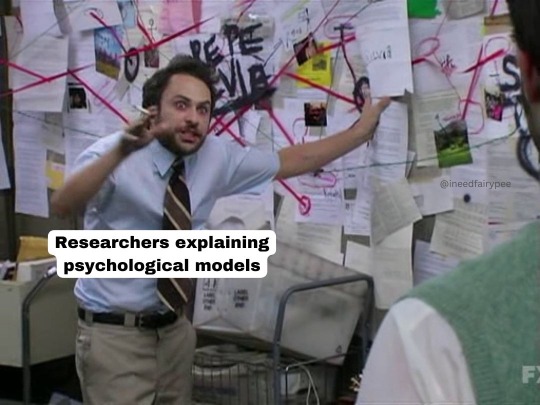
That right there is the model. Can we talk about the model? I’m dying to talk about the model 😩
#psychology#psychology memes#psychology student#psychology studyblr#mental illness#mental health#mental health memes#student memes#university memes#psych student#child psychology#developmental psychology#its always sunny in philadelphia#its always sunny#charlie day#iasip#psychology facts#psychology nerd#original content#oc meme#oc#meme maker#psych#oc memes#ineedfairypee#fairypeememes#I Need Fairy Pee
30 notes
·
View notes